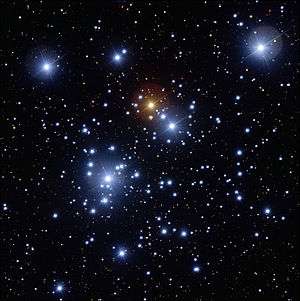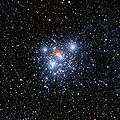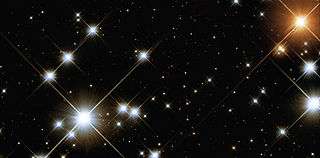Jewel Box (star cluster)
The Jewel Box (also known as the Kappa Crucis Cluster, NGC 4755, or Caldwell 94) is an open cluster in the constellation Crux, originally discovered by Nicolas Louis de Lacaille in 1751–1752. This cluster was later named the Jewel Box by John Herschel when he described its telescopic appearance as "...a superb piece of fancy jewellery". It is easily visible to the naked eye as a hazy star some 1.0° southeast of the first-magnitude star Mimosa (Beta Crucis). This hazy star was given the Bayer star designation "Kappa Crucis", from which the cluster takes one of its common names. The modern designation Kappa Crucis has been assigned to one of the stars in the base of the A-shaped asterism of the cluster
| Jewel Box | |
|---|---|
 | |
| Observation data (J2000 epoch) | |
| Constellation | Crux |
| Right ascension | 12h 53m 42s[1] |
| Declination | −60° 22.0′[1] |
| Distance | 6.4 kly[2] (1.968 kpc[3]) |
| Physical characteristics | |
| Mass | – M☉ |
| Radius | – |
| Estimated age | 16 Myr[3] |
| Notable features | – |
| Other designations | Herschel's Jewel Box,[1] Kappa Crucis Cluster,[1] NGC 4755,[1] Caldwell 94,[4] Cr 264 |
This cluster is one of the youngest known, with an estimated age of 14 million years. It has a total integrated magnitude of 4.2, is located 1.95 kpc. or 6,440 light years from Earth, and contains just over 100 stars.
Discovery and observation
The Jewel Box as a star cluster was first found by Nicolas Louis de Lacaille while doing astrometric observations for his 1751–1752 southern star catalogue Cœlum Australe Stelliferum at the Cape of Good Hope in South Africa. He saw this as a nebulous cluster in his small 12mm. (½-inch) telescope, but was first to recognise it as a group of many stars.[5][6] The name "Jewel Box" comes from John Herschel's own description of it: "...this cluster, though neither a large nor a rich one, is yet an extremely brilliant and beautiful object when viewed through an instrument of sufficient aperture to show distinctly the very different colour of its constituent stars, which give it the effect of a superb piece of fancy jewellery"[5]
Herschel recorded the positions of just over 100 members of the cluster in 1834–1838.[7]
Prominent members
The central part of the cluster is framed by bright stars making up an "A"-shaped asterism.[8] The upper tip of this asterism is HD 111904 (HR 4887, HIP 62894), a B9 supergiant and suspected variable star. It is the brightest member of the A asterism at magnitude 5.77. The brightest star in the region of the cluster is the variable DS Cru (HD 111613, HR 4876), which lies well beyond the A asterism. It is a B9.5 α Cyg variable supergiant with an average visual brightness of magnitude 5.72, but is thought to be a foreground object.[9]
The bar of the "A" consists of a line of four stars. On the right (south) is BU Cru, a magnitude 6.92 B2 supergiant and eclipsing binary. Next to it is BV Cru, a magnitude 8.662 B0.5 giant and Beta Cephei variable. Next in line is DU Cru, an M2 red supergiant that varies irregularly between magnitude 7.1 and 7.6. The last of the four is CC Cru, a magnitude 7.83 B2 giant and ellipsoidal variable.[9]
Each leg of the base of the asterism's outline is marked by a blue supergiant star. HD 111990 (HIP 62953) is magnitude 6.77 and B1/2. The star κ Cru itself is magnitude 5.98 and B3.[9]
Physical characteristics
The Jewel Box cluster is one of the youngest known open clusters. The mean radial velocity of the Jewel Box cluster is −21 kilometres per second (−13 mi/s).[3] The brightest stars in the Jewel Box cluster are supergiants, and include some of the brightest stars in the Milky Way galaxy.[10]
Calculating its distance is difficult due to the proximity of the Coalsack Nebula, which obscures some of its light.[11]
Observation
The Jewel Box cluster is regarded as one of the finest objects in the southern sky.[12] It is visible to the naked eye as a hazy object of the fourth magnitude.[13] It can be easily located using the star Beta Crucis as a guide, and appears as a fourth magnitude object.[14] It is impressive when viewed with binoculars or a small or large telescope. Three members along the crossbar of the A-shaped asterism lie in a straight line known as the 'traffic lights' due to their varying colours.[15]
Gallery
 Wide Field Image of the Jewel Box.
Wide Field Image of the Jewel Box. Digitized Sky Survey 2 image of the Jewel Box.
Digitized Sky Survey 2 image of the Jewel Box. Hubble image of the Jewel Box.
Hubble image of the Jewel Box..jpg) Putting the images in perspective.
Putting the images in perspective.
References
- "NGC 4755". SIMBAD. Centre de données astronomiques de Strasbourg. Retrieved 2006-12-14.
- "WEBDA Open cluster". Results for NGC 4755. Retrieved 2007-01-12.
- Kaltcheva, N.; Golev, V.; Moran, K. (2013). "Massive Stellar Content of the Galactic Supershell GSH 305+01-24". Astronomy & Astrophysics. 562: A69. arXiv:1312.5592. Bibcode:2014A&A...562A..69K. doi:10.1051/0004-6361/201321454.
- "Deepsky Observer Companion Database". Results for NGC 4755. Retrieved 2013-06-08.
- http://www.docdb.net/show_object.php?id=ngc_4755, DOCdb : Jewel Box
- James, Andrew (22 April 2016). "History of the Jewel Box Part One : 1752–1834". Southern Astronomical Delights. Retrieved 2016-04-22.
- Thackeray, A. D. (1949). "The Kappa Crucis Cluster". Monthly Notes of the Astronomical Society of South Africa. 8: 30. Bibcode:1949MNSSA...8...30T.
- James, Andrew (22 April 2016). "NGC 4755 : The Jewel Box "The Jewel of the South" : Introduction". Southern Astronomical Delights. Retrieved 2016-04-22.
- Kharchenko, N. V.; Piskunov, A. E.; Röser, S.; Schilbach, E.; Scholz, R.-D. (2004). "Astrophysical supplements to the ASCC-2.5. II. Membership probabilities in 520 Galactic open cluster sky areas". Astronomische Nachrichten. 325 (9): 740. Bibcode:2004AN....325..740K. doi:10.1002/asna.200410256.
- Burnham, Robert (1978). Burnham's Celestial Handbook: An Observer's Guide to the Universe Beyond the Solar System. New York: Dover Publications. p. 730. ISBN 978-0-486-23568-4.
- Consolmagno, Guy; Davis, Dan (2005). Turn left at Orion: a hundred night sky objects to see in a small telescope. Cambridge, United Kingdom: University of Cambridge. p. 189. ISBN 978-0-521-78190-9.
- Kaler, James B. (1989). Stars and their spectra: an introduction to the spectral sequence. University of Cambridge. p. 13. ISBN 978-0-521-58570-5.
- Ridpath, Ian; Tirion, Wil (2007). Stars and Planets. p. 134. ISBN 978-0-691-13556-4.
- Mobberley, Martin (2009). The Caldwell Objects. Astronomers' Observing Guides. Springer. p. 196. doi:10.1007/978-1-4419-0326-6. ISBN 978-1-4419-0325-9.
- Inglis, Mike (2004). Astronomy of the Milky Way: The observer's guide to the southern Milky Way. Springer. pp. 78–79. ISBN 978-1-85233-709-4.
External links
| Wikimedia Commons has media related to NGC 4755. |
- SEDS: NGC 4755, with a Copyright Anglo-Australian Observatory Image of NGC 4755
- The Jewel Box on WikiSky: DSS2, SDSS, GALEX, IRAS, Hydrogen α, X-Ray, Astrophoto, Sky Map, Articles and images
- A Copyright T. Warner Amateur Image of NGC4755